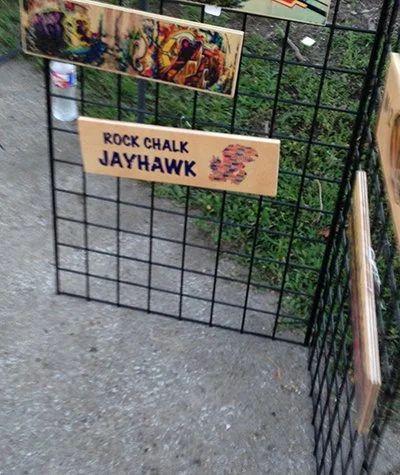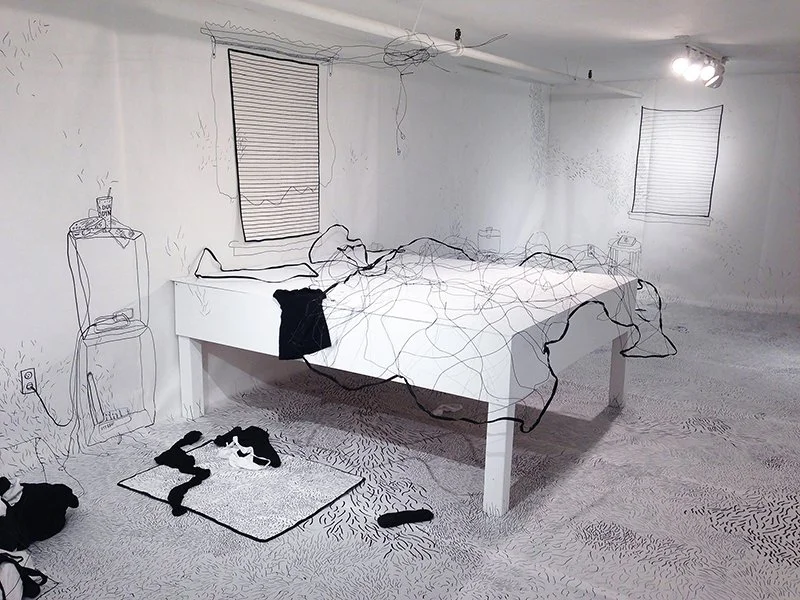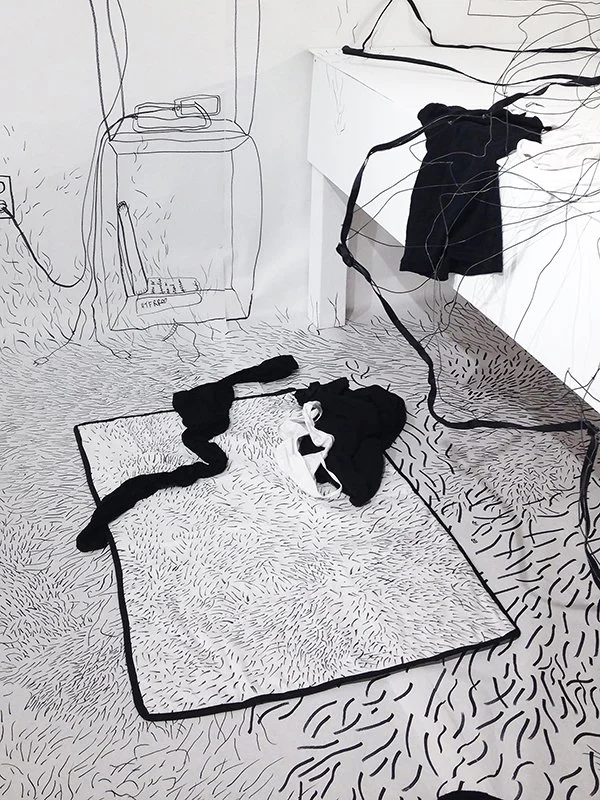Art Hidden Beneath The Sugar Sweat: KC First Fridays
Cotton candy treats at Front/Space
This summer Kansas City has once more filled the streets of the Crossroads Arts
District with cotton candy hauling, iPhone selfie taking, snap-back wearing,
sweaty too-close-for comfort crowds. The few miles of mixed use real estate
area the Crossroads makes up contains everything from traditional commercial
galleries, pop ups, and artist-run spaces. While there are a lot of bodies to weave
into the tight gallery corners and form food cart lines down the streets, it leaves
me to wonder if they are here to be a part of Kansas City’s art culture or to just
be entertained. Typically, art gallery openings are stages set for artists to meet
collectors and celebrate a specific duration of the artists’ work. The scale of First
Friday is far from that cocktail party atmosphere. Instead it has become an
attraction for tourists and suburbanites, and rightfully so. A free event with the
opportunity to experience something outside of cul-de-sack lifestyle.
Kansas City is transformed on the surface into an active bohemian metropolis
filled with people willing to engage with art.
remnants of the art party near Leedyville
In the latter part of the 20th century most industry shifted internationally. With
the movement of jobs, most midwestern cities experienced a large suburban
flight. Cheap rent drew Kansas City artists back into these downtown spaces that
were once left behind. Now the Crossroads is booming and reactivated through
art’s creative placemaking; however, that “place” has become less about artists
and more about promoting real estate, along with the plethora of other corporate
enterprises. The engagement with culture is left to the bystander. I spotted a
woman outside a flower shop gallery peering in through the window to look at
nude figure drawings. Her friends in matching Royals jerseys were busy perusing
the craft table outside; potentially purchasing reclaimed wood pieces painted to
cheer “Jayhawk Rock Chalk”. This woman on the other hand tried to usher her
friends to join her in the space to no avail. Modern and Contemporary Art has a
tendency to make people feel as though they just don’t get it or that galleries are
sacred spaces where they don’t belong. Perhaps, First Friday is about creating a
different experience. Among the impromptu DJ sets, fire breathers, and
hula hoop dancers it seems there is an opportunity here for artists and critics to
turn this hodge-podge into something better than what we have grown to
expect.
street vendor “Rock Chalk Jayhawk” sign
There was a lot of hype around The Art of Data exhibition in June at the new Arts
KC building. Inside it, the exhibition was designed to visually showcase data
utilized in large-scale decision making by city planners. An attempt for politicians
to engage critically with artists, and thus, the community. However ambitious
this potential conversation strived to be, the exhibition was thrown completely
out of balance by classic cars placed in the center of the gallery. Looking at the
work for longer than twenty seconds was impossible due to the conveyor belt of
people pushing everyone along. With each short glimpse, the data felt like it was
being used no different than a disjointed powerpoint presentation. All the work
was so visually disparate from the content it appeared more like a loose prompt
for the artists with little consideration of outcome. Thoroughly dividing the space
and removing the cars could have made for an opportunity to be more critical of
how the individual works flowed together. When looking at The Art of Data as a
whole, an immediate comparison is drawn to You Can’t Hurry Love, an exhibition
last summer at fellow Crossroads’ gallery Front/Space. Off center from the main
drag of Southwest Boulevard and Baltimore, Front/Space is an incredibly small
artist-run gallery. Because of it’s size Front/Space was able to take advantage of
curating a data microcosm.You Can’t Hurry Love, featuring Sean Starowitz,
Matthew Hayden, Nate Kautzer, Andrew Lyles, Taylor Pruitt, and Jessica N
Rogers, showcased city data that highlighted real world problems. Food deserts,
abandoned homes, and a lack of important public spaces, such as parks were all
part of the exhibition’s conceptual engagement. You Can’t Hurry Love presented
data in its raw form next to the artists’ own experimental solutions in formats
such as public art projects, new community organizations, and the release of a
book on art, literature, and civics. It seems that artist-run spaces or galleries
allowing full artistic takeover are the places that create experiences that
keep First Friday from spiraling into a complete carnival. Another instance of
successful artistic takeover occurred on May First Friday at Leedy- Volukos Art C
enter. On a street lined with food trucks and photo booths, hidden amongst the
hovering crowds is Leedy Voulkos Art Center. At the Art Center, many different
exhibitions are presented throughout a conveyor of galleries with no clear
curatorial conversation. Typically what I see here is the work of every Kansas City
Art Institute Foundation year professor mingled next to unknown artists that are
thematically the polar opposite. Art placed in close proximity needs to have some
similar thread of visual or conceptual content. Nonlinear can be interesting but
this is usually just confusing. All gallery rooms at Leedy Voulkos are connected by
doorways that lead you from one gallery and into another but with no specific
flow to that movement. Some exhibitions starting from one end, others ending
opposite the entryway where wall text is placed. All of these disparate choices
continue a disappointing mission to experience great art.
Laundry Day was Last Week image courtesy of Kadie Nugent
Leedy-Voulkos recently opened up the downstairs space specifically for local
undergraduate student work. This windowless unit was transformed this May by
fiber artist Kadie Nugent into a large-scale interactive drawing sculpture hybrid
of a woman’s bedroom. With black and white objects breaking up the scale of the
marks, it was easy to become immersed in this monochromatic world. The depth
of the mark-making was intense and overwhelming. One could not even step into
the space without first putting covers on their shoes and greeting the artist.
Laundry Day was Last Week image courtesy of Kadie Nugent
It was found, an exhibition in the middle of all the chaos with a clear entry point,
a limitation on number of people, and a truly curated story to walk through.
Nugent’s installation shifted my perception. Maybe First Friday isn’t all bad, and
quite possibly there are situations to participate and interact with these
diamonds in the rough. Regardless of what kind of side show entertainment
exists and what people’s motives are for coming, I think First Friday is an
opportunity. It’s a chance for us to take it for what it is, and maybe flip it on its
head. With thousands of people flooding the streets, there have to be some, like
that woman at the flower shop, with a genuine interest in engaging with art.
Art and artists are still going to exist in this district. Even as it pushes artist-run
and alternative spaces further from the centralized action, there are
opportunities for great things to be found. The party of First Friday isn’t going
anywhere and while these two separate camps seem divided there is potential
for crossover. A curated conversation that merges these groups could be the
space in which they find balance with one another.






